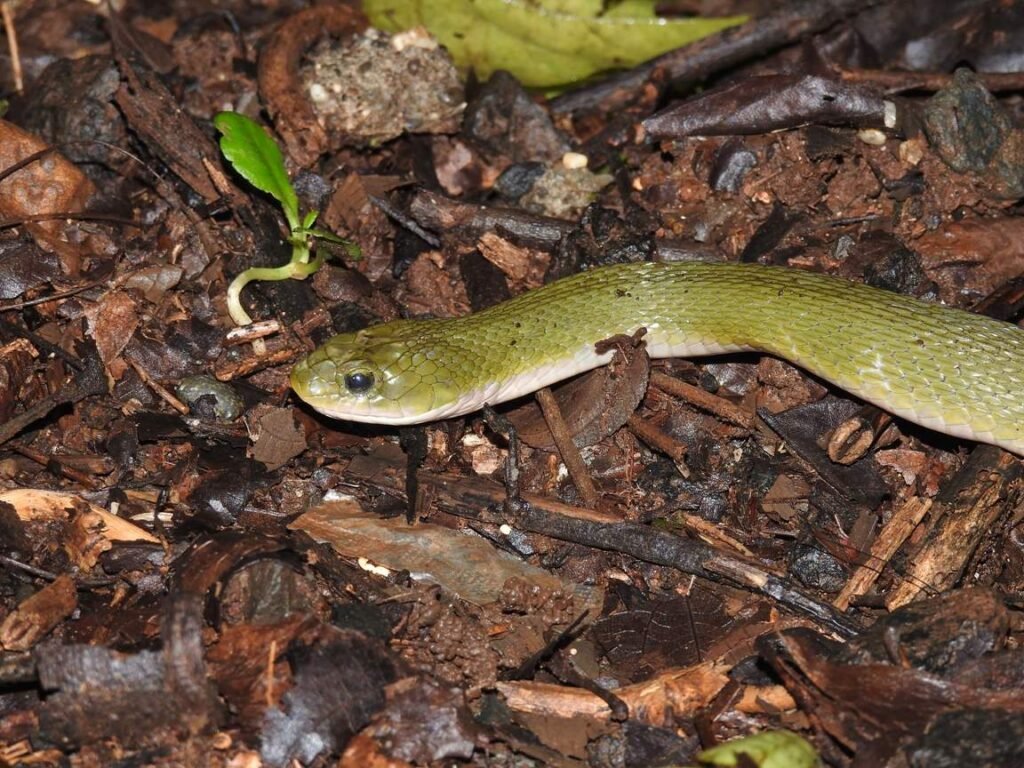Introduction to Green Keelback Snake
The Green Keelback Snake, also known as Macropisthodon plumbicolor, is a harmless, non-venomous snake species commonly found in parts of India and Southeast Asia. It belongs to the colubrid family and is easily identified by its vibrant green coloration, which helps it blend seamlessly into grassy and forested environments. Though it might appear intimidating to some because of its defensive behavior—flattening its head to mimic venomous snakes—it is completely harmless to humans. Despite being relatively common in certain regions, the Green Keelback is often mistaken for venomous species, which contributes to its unnecessary killing. With its docile nature and key role in maintaining ecological balance, this snake deserves awareness and protection. On WildlifeNest.com, we aim to provide accurate, engaging, and respectful information about species like the Green Keelback to educate and spread awareness.
Green Keelback Snake

Species Profile: Green Keelback Snake
| Attribute | Details |
|---|---|
| Snake Name | Green Keelback Snake |
| Scientific Name | Macropisthodon plumbicolor |
| Wildlife Protection Act (WLPA) Schedule | Schedule IV, Wildlife Protection Act, 1972 (India) |
| Regional Names | Marathi: गवत्या (Gavtya) Hindi: हरा धोरिया (Hara Dhoria) Gujarati: લીલવો (Lilvo) Goa: गवत्या, हिरवो नाग (Gavtya, Hirvo Nag) Kannada: ಕಿಡ್ಕ್ಯ (Kidkya) Malayalam: പച്ചനാഗം (Pachanaagam) Odia: ସବୁଜ ଧଣ୍ଡ (Sabuj Dhanḍa) Tamil: பச்சை பாம்பு (Patchchai Pambu) English : Green Keelback, Lead Keelback |
| Physical Description | Medium-sized snake (up to 80 cm), olive-green back with darker crossbars, keeled scales, and a yellowish underside. Head is broad and distinct from the neck. |
| Habitat | Moist deciduous forests, grasslands, and near agricultural lands; often found near water sources. |
| Diet | Mainly feeds on frogs, toads, and sometimes small reptiles. Occasionally feeds on fish or rodents. |
| Behaviour | Shy, non-aggressive, nocturnal or crepuscular; when threatened, flattens head to appear cobra-like. |
| Venomous or Non-Venomous | Non-Venomous |
| Venom Type | Not venomous |
| Venom Effects on Prey | Uses constriction or swallowing; no venom employed |
| Venom Effects on Humans | Harmless to humans; no medical significance |
| Common or Rare Species | Fairly common in suitable habitats |
| Life Span | Estimated 8–10 years in the wild |
| Mating & Reproduction | Oviparous; lays 6–12 eggs during monsoon season. Hatchlings emerge after 60–70 days. |
Introduction to Snakes – Green Keelback Snake Perspective
Snakes are among the most fascinating reptiles on the planet, with over 3,000 species worldwide. The Green Keelback Snake is one such example of nature’s brilliant design. Known for its vivid green coloration and mild demeanor, this snake reflects many of the general traits seen in non-venomous species. Snakes like the Green Keelback have unique anatomical features such as a forked tongue, which they use to smell, and a body built for stealthy movement through grass and underbrush.
Their role in the ecosystem is crucial—they control pest populations like rodents and frogs and, in turn, become prey for birds of prey and carnivorous mammals. Unfortunately, common myths label all snakes as dangerous, leading to unnecessary fear and persecution. The Green Keelback is often misunderstood due to its defensive posturing, but education can help correct these myths. By understanding snakes better, including the gentle Green Keelback, we can foster coexistence rather than fear. WildlifeNest.com emphasizes this awareness, making it easier for readers to appreciate these underrated reptiles.
Habitat and Distribution of Green Keelback Snake
The Green Keelback Snake prefers moist and well-vegetated environments. These include deciduous forests, grassy fields, agricultural zones, and the fringes of wetlands. The species is particularly fond of places near water sources such as rivers, ponds, and canals, where its primary prey—frogs and toads—are abundantly available. It thrives in regions with moderate humidity and avoids extremely dry or heavily urbanized zones. Due to its camouflage, it is often spotted during the early morning or evening when it comes out to hunt or bask.
Geographically, the Green Keelback is distributed across the Indian subcontinent. In India, it has been recorded in Maharashtra, Madhya Pradesh, West Bengal, Odisha, and parts of the Western Ghats. It may also be found in parts of Nepal, Bangladesh, and Sri Lanka. The species adapts well to human-dominated landscapes provided there is sufficient vegetation and food availability.
| Region | Habitat Type |
| Central India | Moist deciduous forests, farmland edges |
| Western Ghats | Dense forests, plantation boundaries |
| Northern India | Marshy areas, grassy plains |
| Bangladesh & Nepal | Near paddy fields and forest streams |
Snake Behaviour – Green Keelback Focus
The Green Keelback Snake exhibits calm and shy behavior, often avoiding conflict unless provoked. It is most active during dawn and dusk, which classifies it as crepuscular. It hunts primarily using its keen sense of smell and sight, feeding on amphibians and small reptiles. Despite its non-venomous nature, it displays a unique defense tactic: when threatened, it flattens its head and raises its front body to mimic the hood of a cobra—an excellent bluff to deter predators.
During the monsoon season, males search for mates by following scent trails left by females. After successful mating, females lay eggs in hidden, damp locations to protect them from predators. The eggs incubate for about two months before hatching. The young are born fully independent and capable of hunting.
This snake uses camouflage as its first line of defense and will quickly flee when given a chance. Its interactions with humans are minimal, and encounters typically result in the snake escaping into nearby vegetation.
First Aid and Medical Treatment for Green Keelback Snake Bites
Though Green Keelback Snakes are non-venomous and pose no medical threat, it’s essential to stay cautious when dealing with any snakebite. In rare cases where a person is bitten, basic wound care is usually sufficient. Clean the bite area thoroughly with soap and water to prevent infection. Apply an antiseptic, and if necessary, a mild painkiller or anti-inflammatory can be used.
Medical attention should be sought if the bite becomes red, swollen, or infected. While there’s no venom to worry about, psychological panic may lead to symptoms such as rapid heart rate or anxiety, which should be addressed calmly. Educating local communities that the Green Keelback is non-venomous can reduce unnecessary fear and improve coexistence.
Global Impact of Green Keelback Snake Bites
Globally, the Green Keelback has not been associated with any fatal or medically significant bites. Since it is a non-venomous species, its global impact in terms of health is virtually zero. Its role is more ecological than medical—contributing to balanced food webs. Most human encounters result in harmless observations or the snake retreating swiftly. However, its mimicking behavior often leads to mistaken identity and, sadly, intentional killing by frightened individuals. Raising global awareness about such harmless snakes can help improve their conservation status.
If You Encounter a Green Keelback Snake on Your Property
- Remain Calm and Assess the Situation: Don’t panic; observe the snake from a safe distance.
- Ensure Safety: Keep pets and children away until the snake moves on or help arrives.
- Identify the Snake (If Possible): Use online resources like WildlifeNest.com to identify whether the snake is dangerous.
- Contact Professional Help: Call local forest department or snake rescuers to remove the snake safely.
- Prevent Future Encounters: Seal holes, maintain tidy gardens, and avoid water stagnation that attracts frogs.
- Educate Yourself and Others: Share awareness about harmless snakes like the Green Keelback in your community.
Tips for Snake Enthusiasts
- How to Safely Observe Snakes in the Wild: Always maintain a respectful distance, use binoculars, and avoid sudden movements. Wear boots and carry a flashlight when exploring snake habitats.
- Tips for Aspiring Herpetologists: Study regional species, join local wildlife groups, volunteer in snake rescue or habitat conservation programs, and always prioritize ethical observation and safety.
Interesting Facts About the Green Keelback Snake
- The Green Keelback is often mistaken for the venomous Green Pit Viper due to its color but has no fangs or venom glands.
- When threatened, it releases a foul-smelling musk to deter predators—a harmless but effective defense.
- Its keeled scales give it a rough texture, helping it grip better while moving through wet grass.
- The Green Keelback is a skilled swimmer and often takes refuge in ponds or water channels.
- Despite its widespread distribution, the Green Keelback is rarely seen due to its camouflage and shy nature.
- It plays a vital role in keeping amphibian populations in check, indirectly supporting agriculture.
- During heavy rains, it can sometimes be seen crossing roads or entering gardens in search of food.
- Unlike many snakes, the Green Keelback can flatten its entire body to increase surface area for bluffing predators.
- It’s one of the few non-venomous snakes that mimic venomous snakes purely for defense.
- Hatchlings are mini replicas of adults and can fend for themselves immediately after hatching.
Frequently Asked Questions (FAQs) about the Green Keelback Snake
1. Is the Green Keelback Snake venomous?
No, the Green Keelback Snake is completely non-venomous and harmless to humans. It often mimics venomous snakes as a defense but poses no medical risk.
2. What does the Green Keelback Snake eat?
Its diet mainly consists of frogs, toads, and occasionally small reptiles or fish. It helps in maintaining ecological balance by controlling amphibian populations.
3. Where is the Green Keelback Snake found?
It is commonly found in India, especially in the Western Ghats, central India, and near agricultural lands, as well as parts of Nepal, Bangladesh, and Sri Lanka.
4. How can I identify a Green Keelback Snake?
Look for a medium-sized snake with olive-green or bright green coloring, keeled (ridged) scales, and a broad head. It may display cobra-like posturing when threatened.
5. What should I do if I see a Green Keelback Snake?
Remain calm and do not harm it. Give it space to escape or contact a local wildlife rescuer. These snakes are shy and will not attack unless provoked.
6. Is the Green Keelback protected under Indian law?
Yes, it is protected under Schedule IV of the Wildlife Protection Act, 1972, which means it should not be harmed or captured.
7. How does the Green Keelback defend itself?
Though it lacks venom, it flattens its head and emits a foul smell to scare away predators—a form of bluff defense.
8. Can I keep a Green Keelback Snake as a pet?
No. In India, it is illegal to keep any wild reptile as a pet under the Wildlife Protection Act.
9. Does the Green Keelback bite humans?
While it can bite if handled roughly, its bite is not venomous and usually results in minor scratches, if any. It prefers to escape rather than fight.
10. How long does the Green Keelback live?
In the wild, this species is believed to live around 8 to 10 years, depending on habitat and food availability.
Watch Wildlife Awareness Videos
For more engaging and educational content on snakes and other wild creatures, don’t forget to visit our official YouTube channel: www.youtube.com/@WildlifeNest
Subscribe and explore fascinating wildlife stories, awareness videos, and rare sightings—all brought to you by Wildlife Nest!
Related Snake Species – Explore More on Wildlife Nest
| Snake Species / Topic | Read Article |
|---|---|
| Indian Rat Snake | Read Article |
| Common Sand Boa Snake | Read Article |
| Indian Rock Python | Read Article |
| Two Step Snake | Read Article |
| King Cobra Secrets – Study Breaks 180 Year Myth | Read Article |
| Slender Coral Snake | Read Article |
| The Green Vine Snake – An In-Depth Look | Read Article |
| Common Cat Snake – All Information | Read Article |
| Banded Krait Snake – All Information | Read Article |
| King Cobra – All Information | Read Article |
| Common Krait – All Information | Read Article |
| Russell’s Viper | Read Article |
| Saw Scaled Viper Snake – All Information | Read Article |
| Cobra Snake – All Information | Read Article |
| The Big Four Snakes of India | Read Article |
| What Are Reptiles? | Read Article |
| The Deadliest Venom | Read Article |
| Most Dangerous Snakes in the World | Read Article |
| The Ultimate Guide to Snakes | Read Article |
| History of Snakes – Evolution, Habitats, Survival | Read Article |


